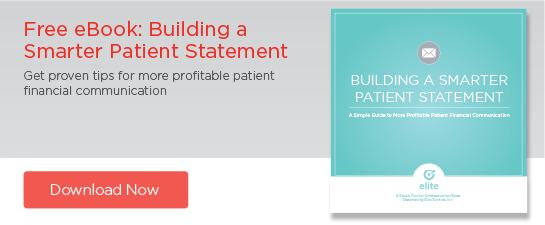Three Key Patient Billing and Payment Trends Worth Watching in 2015
January 13, 2015 •Brian Watson

 Although not quite as headline-grabbing as 2013 – the Healthcare.gov launch and rollout of the Affordable Care Act tends to put last year in rarified air, after all – 2014 provided no shortage of major stories and trends that will shape the healthcare marketplace for years to come.
Although not quite as headline-grabbing as 2013 – the Healthcare.gov launch and rollout of the Affordable Care Act tends to put last year in rarified air, after all – 2014 provided no shortage of major stories and trends that will shape the healthcare marketplace for years to come.
Providers were inundated by plenty of big-issue items in 2014: yet another delay in ICD-10, the threat of massive data leaks and record-setting HIPAA fines, finalization of CMS meaningful use attestation, and the continued increase in patient adoption of high-deductible insurance plans and HSAs.
What are the key trends worth watching from a patient financial communication perspective in 2015?
Read on for three bold predictions for the year ahead – and strategies to help keep your revenue cycle one step ahead.
More Patient Billing Personalization
Steadily rising co-pays and the popularity of high-deductible plans and HSAs are gradually moving a larger portion of the cost of healthcare directly to consumers.
The result is that direct patient payment is becoming a more important revenue stream for many providers.
For example, a 2010 MGMA study reports that 23.2% of the average practice’s revenues come from self-pay sources. And while self-pay represents a far smaller total at most hospitals – a 2012 Moody’s audit of 203 not-for-profit hospitals pegged the total portion of self-pay revenue at 7.3% – it’s also on a steady incline. According to a recent HFMA Financial Pulse, 97% of hospitals surveyed reported a year-over-year increase in self-pay revenue – a third of which described self-pay growth of over 10%.
This trend has clear implications for providers – in 2015 and beyond. Not only are direct patient payments more costly to collect, the likelihood of generating a payment outcome is also much lower. As much as 81% of patient self-pay responsibility ends up as bad debt.
How can you respond to rising self-pay revenue without adding overhead that cuts into revenue margins?
Most self-pay revenue comes from a very small portion of patients – somewhere between 20 and 30% on average. But many providers still use the same account management and patient financial communication strategies for their entire population of self-pay patients.
Or prioritize accounts with large outstanding balances – despite the fact that balance size correlates poorly with return on investment. (For example, a patient that owes several thousand dollars but lacks the financial means to pay isn’t likely to provide a positive return.)
A smarter strategy that’s gaining more and more traction with providers is using data from internal and external sources to truly personalize patient financial operations.
What are the tools that providers will be using to deliver a billing experience that’s more relevant, economical, and effective in 2015?
• Financial Aid Screening
Using a combination of sources – credit score data, internal payment history, and information from publically available programs, like rental, heating, or food assistance – providers are working to proactively identify patients that could qualify for financial aid before they receive an initial statement.
Pre-opting patients into an aid program that better fits their financial profile is smart for several reasons. For example, it reduces bad debt and increases patient satisfaction with the billing process. And it also helps ensure hospitals qualify for nonprofit status by meeting community status guidelines as required under IRS Form 990, Schedule H.
• Propensity-to-Pay Analytics
In addition to financial aid screening, many providers have begun to incorporate propensity-to-pay analytics to better allocate business office resources and personalize the billing process. Using custom intelligence, these models categorize patients into expected revenue segments based upon likelihood of payment.
Instead of waiting through a full statement cycle and the ACA-mandated four month period to begin aggressive collections, propensity-to-pay analytics enable providers to deliver tailored patient financial activities – personalized payment plans or discounts for patients with large balances and a low propensity-to-pay score, for example. Or statement suppression and hands-on attention for accounts that should actually qualify for financial assistance – such as patients with a high-deductible insurance plan that still meet federal poverty guidelines.
• Statement Personalization
With big data gradually transitioning from patient care to financial operations, providers will have more opportunity than ever before to implement statement processing personalization that truly moves the needle on financial outcomes. Many organizations are already integrating propensity-to-pay analytics and patient medal scoring to customize everything from statement cues and instructions to payment options.
Expect better data utilization to also enhance targeting capabilities and improve statement cross-sell/up-sell opportunities. By blending variable print tools with tighter database management, providers are now able to efficiently mine treatment data to provide more relevant, effective trans-promotional messages. For example, offering discounted child-birth classes on the statement of a mother-to-be. Or by expanding cross-channel marketing communication with targeted web landing pages and personalized URLs.
Mobile Rising
Not surprisingly, mobile usage continued to rise sharply in 2014. Consider the following mobile stats from 2014:
• Smartphone adoption increased by 39% year-over-year.
• Forty-two percent of U.S. adults over 18 now own a tablet.
• For the first time ever, Americans used mobile devices more than PCs to access the Internet.
• The percentage of bills paid using mobile devices grew by 69% in 2014.
For consumers, the draw is clear. The anytime/anywhere convenience provided by apps and the mobile web makes it fast and easy to check email, shop, search the web, and connect with social networks.
From a billing perspective, mobile technology offers a perfect opportunity to reach patients using a preferred platform, in near-real-time.
Mobile users tend to have a closer relationship with smartphones and tablets. According to a 2014 Pew study, over two-thirds of cell phone owners check their phones for calls, alerts, and emails – even when haven’t noticed it ringing or vibrating. Nearly half even go so far as to sleep with their phone next to their bed to avoid missing important calls, texts, or app alerts during the night.
With the right tools and technology, providers can leverage that level of channel engagement to better personalize the patient billing experience – not to mention accelerate payment and reduce collection costs.
All of which suggests that if you don’t already have a mobile billing and payment strategy in place, you probably will very soon.
• SMS Text Messaging. Billing alerts can be used to quickly remind patients of their financial responsibilities at various points throughout the treatment process. For example, a reminder notice might be sent immediately after treatment if a patient didn’t make a co-payment while in the office. That patient would also receive a message linking to their online statement, plus periodic reminders – if they haven’t made a payment on time.
• A Mobile-Friendly Portal. Don’t assume that your online billing payment portal will automatically provide an intuitive browsing experience for mobile users. Screen sizes are becoming more varied and more device providers are offering proprietary, mobile-only web browsers.
Whether it’s through a responsive, mobile-optimized website or a mobile-only application, your portal should enable patients to quickly and easily access their account from any device. That means stripped-down navigation, clean design, and large, touchable elements that easily translate to smartphones and tablets.
Moving to a Multi-Channel Model
Consumers are increasingly billing and payment omnivores, receiving statements and financial updates from multiple channels – in the mail, over the phone, via text message, or through email – depending on the biller.
For example, a typical consumer might receive a monthly electric bill via email, while still using traditional mail delivery for statements from their dermatologist. And many use more than one channel to receive bills from the same company – consumers often dubbed “double dippers”.
Payment is handled similarly. One-in-five consumers admits to changing the way they pay the same bill each month, due to availability of funds, the payment due date, or the size of the outstanding balance. Over two-thirds of all U.S. households use more than one channel to pay a bill each month, with 52% using three or more methods. And the average consumer uses three different ways to pay each month.
The upshot? At least for the foreseeable-future, your patients expect to have their cake and eat it too when it comes to billing and payment channels: the ability to receive and pay bills how they want, when they want, using the payment sources – credit, debit, HSA, and ACH – they want.
When those options are lacking – or difficult to use – approval of the billing process will suffer. For example, 43% of consumers in a recent Fiserv survey reported that having access to multiple statement delivery and balance payment channels increases their satisfaction.
How can you meet the demand for a multi-channel approach to patient billing and payment – in addition to the mobile options discussed earlier?
• Traditional Statement Processing. Despite the growing popularity of online and mobile options, traditional statement print and mail remains a consistent billing channel for consumers. About 76% of all bills delivered are still paper-based.
However, one key change in traditional statement delivery over the last few years is the continued decline in paper-based payment remittance. Check reimbursement reached an all-time low in 2013, down to just 15% of total payments made – less than half the number of checks that were paid in 2003. That has many providers now blending channels – such as delivering a paper statement to patients, but heavily emphasizing simple online payment tools like a guest pay website that doesn’t require enrollment.
• Online Billing and Payment. Nearly seventy percent of consumers reported paying a bill via an online channel in 2014. However, with adoption decreasing slightly for the second straight year, it’s becoming clear that offering an online option alone is no longer enough.
Today, providers are mixing platforms and tools to maximize online payment participation and eStatement adoption. For example, many now offer a full billing patient portal with eStatement viewing alongside a guest pay website to capture the billing needs of a greater portion of the self-pay population. Others are experimenting with ways to use the Internet to simplify the billing process – such as reconciling patients’ insurance benefits with bills from all of their healthcare relationships to provide an accurate, easy-to-understand snapshot summary of deductible status.
• Inbound/Outbound IVR. As an outbound tool, automated calling (IVR) solutions are increasingly used by providers supplement paper, online, or mobile billing channels. One common application is as a bill pay reminder. Not only are automated payment reminder an efficient way to increase cash collections, they’re also appreciated by consumers – in a recent Fiserv survey, 77% of respondents said bill pay due reminders increases their satisfaction.
For inbound operations, IVR helps patients quickly complete billing tasks. Many providers have begun to add a separate automated phone number where patients can easily complete self-service tasks like making a payment, checking their account balance, or updating insurance 24/7 regardless of billing office hours.
Conclusion
If the last few years are any indication, the healthcare industry is in for some big changes in 2015.
From a revenue cyle perspective, some of the financial communication trends that I’ll be tracking most closely this year include:
• More widespread use of patient demographic and financial analytics to personalize statement processing and related billing activities
• How the rise in popularity of mobile devices can help accelerate payment and enhance the patient billing experience
• Providers’ willingness to provide patients with more options to receive and pay their bill – including more technology-reliant, self-service tools.
What healthcare financial or patient billing trends will you keep a close eye on in 2015? Be sure to share your thoughts in the comments section below.
Get Updates
Featured Articles
Categories
- Charity Care Management (1)
- Compliance (2)
- Customer Service (8)
- Digital Front Door (1)
- Direct Mail (6)
- eBilling (1)
- EBPP (34)
- ESL Statement (2)
- eStatement (1)
- Healthcare Channel Partner Billing (1)
- IVR (3)
- Mobile Payment (11)
- Online Billing and Payment (6)
- Online Patient Payment (17)
- Outsource Print Management (4)
- Paperless Billing (4)
- Patient Engagement (2)
- Patient Friendly Billing (21)
- Print and Mail (7)
- QR Codes (1)
- Quick Pay (7)
- Security (1)
- Self-Pay Patients (9)
- Self-Pay Revenue (4)
- Statement Design (32)
- Statement Print and Mail (1)
- Statement Printing and Mailing (28)
- Statement Processing (36)
- TransPromo (1)
- Up-Front Billing (1)


